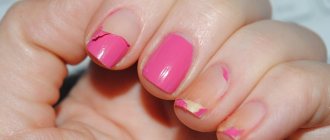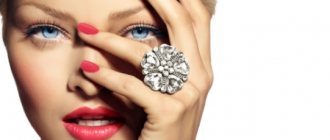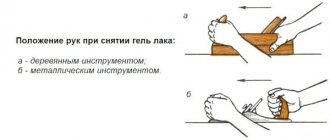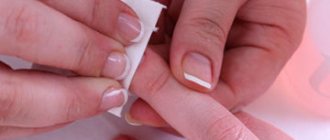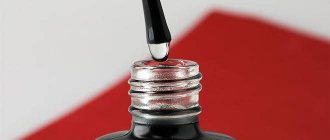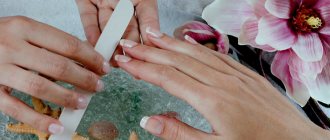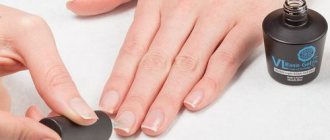Types of nail detachments
Nail technicians often have to deal with the following complaints from clients:
- Pieces of the coating break off along the edges of the nail at the ends. Mostly, owners of square-shaped nails face this problem.
- The gel polish begins to gradually come off at the cuticle.
- The coating peels off along the entire perimeter of the nail and is easily removed as a single film.
As a rule, the coating begins to crack at the edges of the nail a few weeks after the manicure. But this is also possible in cases where a woman does not use gloves when washing dishes with a hard sponge.
If the varnish film peels off a few days after application, we can say that the master violated the coating technology.
The best manufacturers
Opinions about varnishes, of course, vary greatly. To the owner of healthy nails, almost any varnish seems excellent. But those who have loose and uneven nail plates are much less fortunate.
- IsaDora is a well-known Swedish brand that offers a very rich range of colors. The secret of a good manicure from IsaDora is not only the quick drying of the product, but also a special wide brush.
- The famous American manufacturer Orly offers varnishes, base coats, dryers, etc. The Orly nail polish collection contains products enriched with vitamins.
- The Polish brand Belweder produces many medicinal products. The company's varnishes not only decorate nails but also strengthen them. Belweder products are easier to find in pharmacies than in salons.
- OPI – according to statistics, accounts for half of all varnishes sold in the country. The secret is the huge variety. And this applies to color, texture, and cost.
- Among the gel polishes, VINYLUX from CND stands out. The product is offered as a “weekly” varnish, and, judging by the reviews on the forum, it really is a record holder for “longevity”.
- The company's main rival is the famous Revlon. The products of this company do not need advertising.
Detachment of gel polish caused by body characteristics
Each person is unique, just like his nails, and accordingly, the coating can be applied in different ways. In this case, choosing the right means is only possible through experimentation. The problem may be as follows:
- Hands and nails are too wet. Often there is a problem of hydration, which is solved by a more “powerful” primer or by applying a base twice. For reliability, this product is also applied to the ends of the nails.
- Fragility of nails, which shortens the wear period of the coating. For example, if the nail plate is not strong enough, the tips constantly break. It also happens that a girl independently decides to cut or file her nails, violating the integrity of the coating.
- The nails are very soft. In this case, the gel polish is quite difficult to apply, so a strengthening procedure must first be carried out.
- The presence of stripes, grooves, tubercles and other deformations that disrupt the surface of the nail. In this case, the coating can really peel off quickly if you do not use special products for gel polish.
- There are internal diseases of the body that reduce the wear time of gel polish. These are: diseases of the nervous system, hormonal imbalances and disorders of the immune system, previous surgery, taking antibiotics, diabetes mellitus. If the reasons described above are excluded, it is necessary to take into account the possibility of a problem with the body.
In addition to using various manicure products described above to eliminate the problem, it is recommended to get rid of the root cause. Today there are many folk remedies and pharmacy complexes that can cure soft or brittle legs.
Errors in manicure technology
Before applying gel polish, you must carefully treat the nail plate
- Poor quality treatment of the nail plate . When processing a natural nail plate, it is important to remove the shiny top layer using a nail file or buff. And a common mistake is insufficiently careful treatment of the nail plate at the cuticle itself. For easy access to all parts of the nail, it is better to use the corner of the buff; it is capable of treating hard-to-reach places where a nail file cannot reach.
- Manicure errors . Peeling of the gel polish can be caused by a thin film remaining on the nail along the entire cuticle line - pterygium. To avoid this, you need to do a hardware manicure or carefully treat the cuticle area of the nail with a pusher.
- Oily mark on nails . Gel polish can peel off if a person, after treating the nail plate with a buff, touches the nails with their fingers, which leaves greasy marks on the nails. This problem can be solved by degreasing the surface of the nail, and you need to remember that touching the nails while working is unacceptable.
- A wet primer can also cause your manicure to peel off. Apply the primer in a thin layer, in this case it dries quickly.
- A wet nail plate always leads to peeling of the gel polish, in which case the coating comes off the nail entirely like a film. Do not steam your nails before the procedure. If you have doubts about the moisture content of your nail, use a dehydrator.
- Gel polish should not get on the cuticle . If this happens, the gel polish must be removed from the skin before drying in the lamp. Try to step back half a millimeter from the cuticle, otherwise this will lead to peeling of the gel at the base of the nail.
- Leaving the free edge of the nail unsealed . Or another mistake typical of unskilled craftsmen is filing down the sealed edge. The same situation can occur when designing a nail tip that is too thick. Uneven load on the nail promotes peeling. If this is the case, then the only solution to the problem is to file away the excess material to lighten the load on the nail.
- Sometimes there is separation of one layer of gel from another , for example, color from the base. To avoid this mistake, use coatings without a sticky layer for the base and gel polish and with a sticky layer for the top coat. Tops without a sticky layer are prone to cracking.
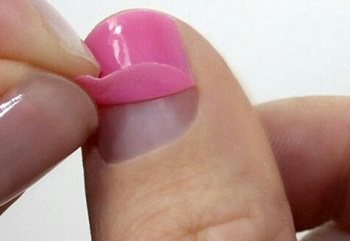
Manicure on a wet nail plate is one of the common causes of gel polish peeling off.

When applying gel polish, do not forget to seal the free edge of the nail
You can find even more professional secrets that will help you avoid gel polish peeling in the video:
Each layer of gel nail coating should be thoroughly dried in a lamp. Therefore, it is necessary to ensure that the lamp is working properly and at full power. Change lamps on time to ensure they work. Use lamps of sufficient power, otherwise you risk not drying the gel enough, which will doom your manicure to peeling off.
Gel polish coating - how not to be disappointed?
Gel polish will last a long time if you follow a few simple rules:
- Before applying gel polish to your nails, you should definitely get a manicure. This will allow you to prepare your nail. It is not recommended to use nail baths; it is better to choose a dry cut type or European manicure. Such techniques are designed to protect the nail from excess moisture, which manifests itself negatively when the nail plate comes into contact with materials.
- During the process of covering the nail, it is unacceptable to touch it with your hands. Microparticles can get onto the degreased plate and subsequently lead to deformation of the coating.
- After completing the manicure, it is not recommended to immediately go wash dishes or do cleaning. It is better to postpone such matters until the next day.
- You should not file overgrown nails yourself. In this way, the integrity of the sealed end is compromised, and moisture and air get under the coating.
- It is highly recommended to use hand protection when washing dishes or floors. They will protect not only the manicure, but also the skin of the hands.
- You must be careful when staying in places with high humidity. Frequent visits to the solarium or sauna can cause the varnish to quickly begin to crack.
Following all these simple rules will help avoid peeling, cracking and other deformations of the gel polish coating. If you neglect them, the consequences can be quite unpleasant and overshadow the joy of a new beautiful manicure.
Experts' opinion
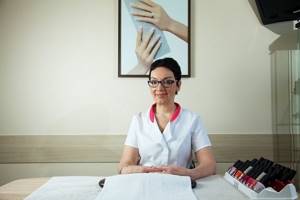
Why doesn’t gel polish stick well to nails if there are no health problems, you are not pregnant and there is still a lot of time before the next menstrual cycle starts? In this case, you should watch the work of your master, perhaps this is the reason.
According to nail art experts, manicurists most often make the following mistakes in their work:
- The cuticle was not completely removed. Cleaning the nail of excess skin and cuticle is very important because they prevent the gel from bonding to the pores of the nail.
- The nail plate was poorly processed. Before applying the varnish, the surface of the nail must be filed with a special grinding buffer, the abrasiveness of which must be at least 9 gits.
- The technician did not degrease the nail plate or applied an insufficient amount of product. Dust, dirt, sweat and other factors not only prevent an even coating, but can also reduce the efforts of the master to nothing, as a result of which the work will be done in vain.
- Shellac does not adhere very well to nails that are damp from sweat. If the client suffers from excessive hand sweating, the master must treat the nails with a pre-primer or bonder.
- A very thick layer of base coat, color or sealer, will not last the required 2-3 weeks on the nails. All these products must be applied in a thin layer in stages and dried well under a lamp.
- A poorly sealed layer is another reason why gel polish cracks on your nails. The master must thoroughly coat the nail cut with a fixative.
- The use of hybrid materials does not give good results. If the salon offers you to apply a fixative base, refuse this idea. Varnishes built on the 2-in-1 principle are noticeably inferior in quality to single-phase materials.
In addition, we should not forget about the quality of the materials used for shellac. Old varnishes, gels and bases or cheap materials can be used in manicure art, but in this case you should not hope that you will shine with beautiful nails for a long time.
In addition, experts do not recommend doing manicures with gel polish too often. The fact is that coating removal reagents greatly destroy the natural structure and lead to brittleness and splitting of nails. The same can be said about the method of removing gel polish by filing. The best option is to give your hands a short break at least once every 2 months.
How to nourish and restore nails: moisturizing the nail plate
To keep your nails healthy and not break or peel, it is important to maintain the water-salt balance in the body: drink the required amount of clean water daily. Usually it is 2 liters, but it can be 1.5 or 3.
- Take baths with nutrient solutions. Salt baths strengthen the nail plate. You can add a few drops of olive or castor oil, as well as lemon oil. It is enough to do such a bath once a week, keep your nails in it for several minutes, and you will already see the result of the procedure.
- Do not use nail polishes and gels, cleansers with formaldehyde and toluene.
- Buy cuticle oil and apply it daily. The product will not only restore the cuticle, but also saturate the nail plate with nutrients and make it more flexible, dense and elastic.
- After a manicure, be sure to use cuticle oil and apply cream to your hands. Choose several suitable products for yourself. You should always know how to strengthen your nails. Products based on shea butter, lemon oil or sea buckthorn are well suited for these purposes. Such creams and the oils themselves nourish both nails and hands well. A manicure for peeling nails involves only surface treatment and nourishing creams and oils: no varnish!
- To prevent delamination, include in your diet vitamin complexes for nails containing vitamins A, E, B, calcium, magnesium, phosphorus, iodine, selenium. It is recommended to take vitamins as prescribed by your doctor.
- Make nourishing or paraffin masks regularly. Hands are dipped into liquid paraffin for 5 minutes, which creates a sauna effect after hardening. Hands become smooth, and nails become noticeably stronger and glossier. This can also be done as part of home hand care procedures, without visiting a salon.
- Include fermented milk products and liver in your diet, as well as foods with antioxidants. For example, grape seed oil. When there are not enough vitamins and minerals, white spots appear on the fingernails.
- Minimize your use of alcohol and tobacco. For peeling nails, these are the first enemies.
- Play sports: the general tone of the body will inevitably affect the health of the nails. 30 minutes a day three times a week is enough.
What else should you avoid if possible? From the regular use of medications, which, as the saying goes, cure one thing and cripple another. Very often, for example, due to hormonal drugs, nails, skin and hair deteriorate.
Why nails peel: causes and types of nail diseases
An unhealthy condition of nails can result in an unusual color, excessive hardness, and delamination. Various diseases cause specific changes in the structure of the nail. They arise due to external, internal and psychological factors.
External causes of unhealthy nails
- Chemical exposure (household chemicals, hard water, plant juices, soil - when working in the garden - and so on).
- Using varnishes with formaldehyde and aggressive agents with acetone to remove nail polish.
- Improper removal of nail extensions.
- Constant hypothermia of the body or being in conditions of low air humidity.
- Damage caused by bruises, injuries, regular exposure to tools or devices. For example, the marigolds of people who work in the soil, shoemakers, and musicians are often in poor condition.
Internal causes of nail disease
- Disturbances in the functioning of internal organs.
- Metabolic disorders due to diseases or a poor diet that lacks trace elements and vitamins. In general, it is very important to monitor your diet. After all, it’s easier to prevent the problem than to later look for ways to deal with peeling nails.
- Skin diseases that also affect the condition of the nails (psoriasis, lichen, fungal infection, epidermolysis, x-ray dermatitis, etc.).
- Hormonal imbalance in adolescence, during pregnancy, lactation, menopause, in stressful situations, due to certain diseases.
- Poisoning with drugs or heavy metals. This also includes regular exposure to toxic substances (tobacco, alcohol, narcotic poisons) on the body.
Psychological reasons
All psychological causes are a consequence of stressful effects on the human nervous system. Certain pathologies develop. Stress itself leads to a malfunction of internal organs, which certainly affects the condition of the nails.
Onychotillomania
- a pathology in which a person tends to break, tear off, or somehow destroy his own nails.
Onychophagia
- a person bites his nails without controlling this process.
How to paint
The first stage of preparation for the procedure is quite traditional. You need to carefully push back the cuticle, remove excess skin, and clean the surface of the nail plate from traces of dirt and grease. If the nail is split, it must be carefully trimmed with a nail file. In this case, it is necessary to avoid wet manicure, since the absorbed moisture will subsequently lead to the appearance of blisters on the surface of the varnish coating.
At the second stage, a special primer is applied, which serves to ensure more reliable adhesion of the varnish to the surface of the nail. The primer is safe for the nail plate and acts as a kind of primer that strengthens weak nails. It is also used to process the end of the nail plate.

The third stage requires special patience, since now you need to apply several layers and give each one time to dry. First, the master thinly applies a base gel, which ensures a strong bond between the keratin that makes up the nails and the synthetic gel. It prevents the coloring pigment from penetrating into the deeper layers of the nail plate.
Gel polish is applied on top of the base in two or three thin layers, very carefully, bypassing the side rollers and cuticle. The last layer applied is a special finishing gel.
When it is completely dry, the top dispersion layer is removed with a special product, which gives the manicure a salon shine and moisturizes the nail plate.

After application, each layer must dry completely. Ultraviolet or LED lamps are used for this procedure. Under the influence of light rays, the gel polish firmly adheres to the previous layer due to the polymerization process.
Professionals use special equipment that must match the brand of decorative coating. Most often used:
- UV lamps with a power of 36 W, which dry the coating in 40 seconds, however, due to its size, such equipment is more suitable for beauty salons;
- nine-watt UV lamps, which work slower, 1.5 - 3 minutes, but are less cumbersome and good for home use;
- LED lamps are more economical than ultraviolet lamps, but no less effective.
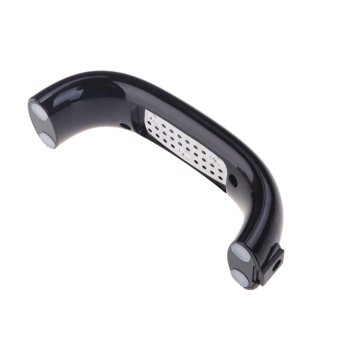
The first 2 layers of gel polish should be dried for at least 2-3 minutes under nine-watt UV lamps (40 seconds under LED or UV lamps at 36 W), the last, third layer - one and a half minutes (under a UV lamp at 9 W) or 40 sec. under LED or high-power UV lamps.
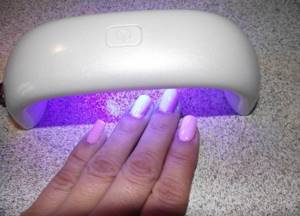
Professional lamps significantly speed up the drying process, and if all deadlines are met, your fresh varnish coating will not be afraid of contact with any objects.
What to do if your nails peel and break: treatment and manicure
General recommendations are for everyone, regardless of what caused the splitting and brittleness of your nails.
If the reason is a violation of nail treatment technology, we recommend that you carefully read the following articles:
- How to do a European manicure.
- How to do a trim manicure and care for the cuticle.
- How to do a hardware manicure. Description of the procedure.
- How to choose wire cutters.
- How to choose a file.
We recommend choosing a crystal or laser file. Laser and crystal files are the most delicate tools that can be used to “solder” peeled nail flakes. You need to file the nail in the direction from the edges to the center and from the tip to the base. Sand only dry, unpainted nails.
Check the quality of polishing using nylon tights. Run your nail along them: it should glide smoothly and not catch on the threads.
Sand any imperfections as soon as you find them. File the tip of the nail as soon as it breaks. Before treatment, wipe the nail with an antiseptic. If your nail is damaged by an infection (fungus, eczema), sterilize the file in a special solution after each use. Please note that in such cases, sandpaper files are not sterilized, but thrown away. To save money, it is wiser to purchase glass or crystal, which can be disinfected and washed.
Do not polish your nails for more than 2 minutes: there is a risk of thinning the nail plate.
